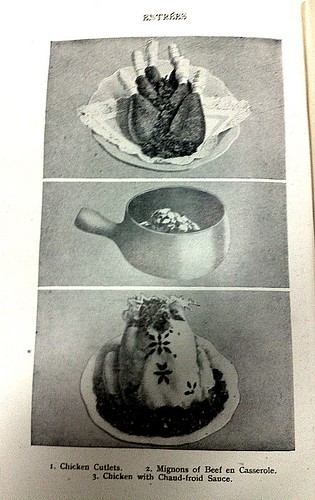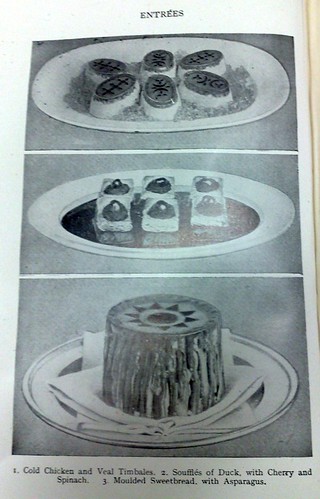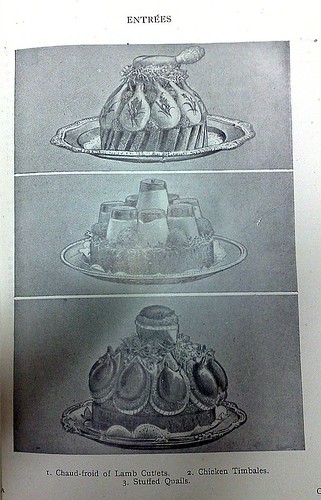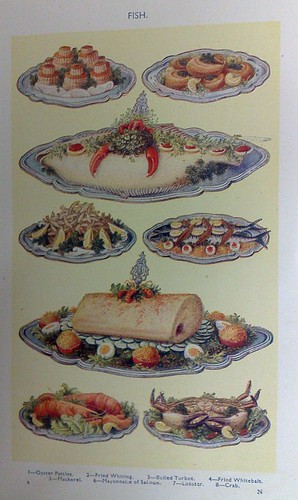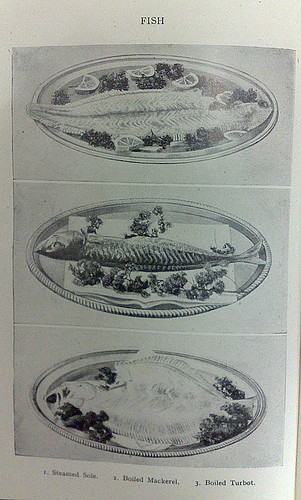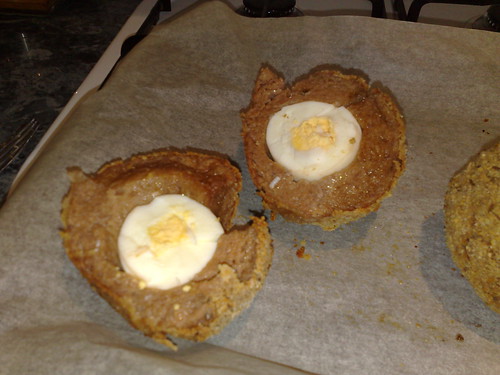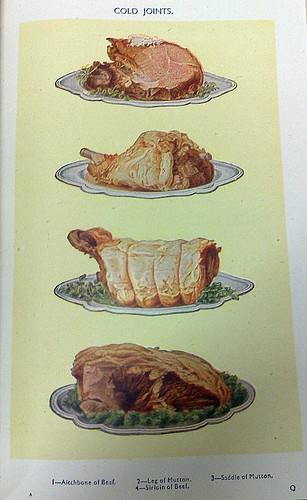
Tuesday, September 29, 2009
It is more fun to talk with someone who doesn't use long, difficult words but rather short, easy words like "What about lunch?" - Winnie the Pooh
 LUNCHEONS.
LUNCHEONS.Luncheon Dishes. - Ordinary luncheons, as a rule, have fewer courses than dinner, but in other respects they are almost identical, and may comprise hors d'oeurves, soup, fish, meat, poultry or game, sweets and savouries. Hors d'ourves are almost invariably served as a preliminary; either soup or fish is frequently omitted, and the sweets provided are of a comparatively simple characters, such as soufflés, milk puddings, fruit tarts, compôte of fruit, etc. A joint of meat, a fruit tart or stewed fruit, or a suet or milk pudding, constitute the luncheon of many who dine late, more especially when the household includes children who share the midday meal. Or the luncheon may consist of the cold remains of the previous night's dinner, in which case parts of birds, tarts, creams, jellies, etc., are usually made more presentable by being cut into portions suitable for serving, and neatly arranged on a dish.
The Service of Luncheon varies considerably, for while luncheon à la Russe may be said to predominate in fashionable circles, yet a very large number of people still follow the older custom of having all the hot dishes placed upon the table.
The table arrangements for luncheons served à la Russe are the same as for dinner, the centre of the table being occupied by nothing but fruit, flowers, cruets, and other articles used in the service. Under any circumstances, each cover should comprise one large and one small knife, a fork, and a small fork for the hors d'oeuvre, but the old custom of placing a small fork and dessertspoon is no longer followed, except at informal meals. When fish is included in the menu, the knife and fork provided for its service must be laid to the right and left, on the outside of those already on the table, and if soup is to be served, a soup spoon or a tablespoon must be placed to the right, outside the fish knife. According to present fashion, the maximum alllowed to each cover is two knives and two forks, one fish knife and fork, and one soup spoon, all of which should be placed a quarter inch from each other and one inch from the edge of the table. When the dishes are placed upon the table, instead of being served à la Russe, each dish to be carved must be accompanied by appropriate carving-knives and forks, and each entrée, or sweet, by a tablespoon and fork. The wine to be served will determine the number of glasses to be used. If, say, claret, hock and minerals are selected, then tumblers, hock and claret glasses should be provided; but glasses should never appear on the table unless the wine to which they are appropriate is to be served.
Table-napkins should be placed in the space between the knives and forks.
Friday, September 25, 2009
Breakfast is the most important meal of the day. It's unbelievably important. You should eat breakfast at least three times a day.
BREAKFASTS.
Breakfast Dishes. - The moral and physical welfare of mankind depends largely on its breakfast, yet many of those upon whom the responsibility of providing it rests do not realize how far-reaching may be the effects of a good or bad meal. A being well fed and warmed is naturally on better terms with himself and his surroundings than one whose minds and body are being taxed by the discomfort and annoyance of badly cooked or insufficient food. In small households there is a constant complaint of lack of variety, and the too frequent appearance of bacon and eggs, which, it must be confessed, is the sheet-anchor of the English cook.
But, notwithstanding this plea for "something new", there are over two hundred ways of dressing eggs, to say nothing of grilled chops, steaks, cutlets, kidneys, fish and mushrooms, anchovy and sardine toast, sausage rolls, sausages grilled, boiled or fried, meat patties, rissoles, croquettes and croûtes, fish omelet, fish-cakes, fish soused and kedgeree, pressed beef, galantine of beef, potato chips, potatoes fried in a variety of ways, and a host of other inexpensive and easily-prepared dishes. Many housewives cannot, of course, afford to provide some of the dishes enumerates above, but the present work includes an almost endless variety of preparations of a simple characters, which might be advantageously used to relieve the monotony of breakfast.
Which all makes perfect sense. Breakfast is very important, and if you end up eating the same cereal over and over again, it can quickly grow dull and unappealing.
The Service of Breakfast varies very little, no matter how simple or elaborate the meal. On the cottage table, the breakfast-ware, teapot, bread, butter, and dish of bacon, or whatever constitutes the homely fare, all have their allotted places, although the arrangement of the respective articles may not agree with everybody's sense of fitness. When the table is a small one, the centre of it may be occupied by a single vase of flowers, or bowls of flowers placed equidistant from each other may form the decoration of a larger table. Other appointments depends on the number of persons to be seated and the dishes to be served. When the meal consists of one dish, a knife and fore, either large or small, according to choice, and a small knife for bread and butter, should be laid for each person. When fish is included in the breakfast menu the knife and fork provided for the service must be places to the right and left outside the ordinary knife and fork. When the breakfast comprises several dishes, usually three knives and two forks are laid instead of one, but there is at the present time a steadily growing tendency to avoid unnecessary display of silver and cutlery. A small late for bread and butter is places outside the forks, and the napkin is laid in the space between the knives and forks. No hard-and-fast rules can be laid down for the disposal of the cruets, butter, toast, eggs, marmalade, etc., but they all appear on a properly-appointed table, arranged according to the space available and , of course, some symmetrical order must be maintained. As a rule, once end of the tale is occupied by the breakfast ware, sugar, hot and cold milk, tea and coffee pots, and when only one hot dish is provided, it is nearly always places at the opposite end of the table. Porridge, bread and butter and other cereal foods may be very daintily and easily be served in fireproof glassware; the same applies to stewed fruit.
Okay, not sure what Mrs B would think about toast scoffed in front of the morning telly shows...
Breakfast being, in many homes, such a moveable feast, an electric hotplate is invaluable for keeping the various dishes warm, and hot toast made with one's own hands in an electric toaster, on the table, tastes delicious indeed. An electric egg boiler or poacher on the breakfast table will save many an egg from being cooked in the kitchen and from being "not wanted" in the breakfast-room.
Such courtesy towards unwanted eggs. *sniff*
When cold dishes are served, such as ham, tongue, potted meats, sardines, etc., they may be placed down the sides of the table.
Which all makes perfect sense. Breakfast is very important, and if you end up eating the same cereal over and over again, it can quickly grow dull and unappealing.
The Service of Breakfast varies very little, no matter how simple or elaborate the meal. On the cottage table, the breakfast-ware, teapot, bread, butter, and dish of bacon, or whatever constitutes the homely fare, all have their allotted places, although the arrangement of the respective articles may not agree with everybody's sense of fitness. When the table is a small one, the centre of it may be occupied by a single vase of flowers, or bowls of flowers placed equidistant from each other may form the decoration of a larger table. Other appointments depends on the number of persons to be seated and the dishes to be served. When the meal consists of one dish, a knife and fore, either large or small, according to choice, and a small knife for bread and butter, should be laid for each person. When fish is included in the breakfast menu the knife and fork provided for the service must be places to the right and left outside the ordinary knife and fork. When the breakfast comprises several dishes, usually three knives and two forks are laid instead of one, but there is at the present time a steadily growing tendency to avoid unnecessary display of silver and cutlery. A small late for bread and butter is places outside the forks, and the napkin is laid in the space between the knives and forks. No hard-and-fast rules can be laid down for the disposal of the cruets, butter, toast, eggs, marmalade, etc., but they all appear on a properly-appointed table, arranged according to the space available and , of course, some symmetrical order must be maintained. As a rule, once end of the tale is occupied by the breakfast ware, sugar, hot and cold milk, tea and coffee pots, and when only one hot dish is provided, it is nearly always places at the opposite end of the table. Porridge, bread and butter and other cereal foods may be very daintily and easily be served in fireproof glassware; the same applies to stewed fruit.
Okay, not sure what Mrs B would think about toast scoffed in front of the morning telly shows...
Breakfast being, in many homes, such a moveable feast, an electric hotplate is invaluable for keeping the various dishes warm, and hot toast made with one's own hands in an electric toaster, on the table, tastes delicious indeed. An electric egg boiler or poacher on the breakfast table will save many an egg from being cooked in the kitchen and from being "not wanted" in the breakfast-room.
Such courtesy towards unwanted eggs. *sniff*
When cold dishes are served, such as ham, tongue, potted meats, sardines, etc., they may be placed down the sides of the table.
Tuesday, September 22, 2009
A good meal ought to begin with hunger
As I am preparing for the dinner party of the season for my up coming birthday, I thought I should explore the importance of meals.
MEALS
REGULARITY.
One important consideration with regard to meals is their regularity, and, speaking from the health point of view, it is most essential. A meal that we have waited for an hour too long is often one that we fail to appreciate; and while to the healthy irregularity is dangerous, to the delicate it is injurious. It is not difficult to determine what are the best and most convenient times to take our meals, and when once these hours are fixed, the next thing is to insist on punctuality, not only for those who serve them, but for those for whom they are prepared.
Whoops. Here we get a big F. Our breakfast and lunch are usually around the same time but due to the variety of different things going on at night time, dinner is anywhere from 6.30 to 9.30.
.jpg)
TABLE ARRANGEMENTS
There are few general rules which apply equally to mansion and cottage. However simple may be the meal, and however coarse in texture the cloth, it should be clean, free from creases, and arranged smoothly with the centre fold forming a true line the whole length of the table. The knives should be clean, bright and sharp, and the silver clean and well polished. When properly trained servants are kept, contrary conditions seldom exist; neither would they in small households, where the work devolves upon an inexperienced housemaid, if a few simple rules were strictly enforced, such as removing the crumbs and folding the cloth on the table, instead of allowing it to be shaken and folded outside the room; that after each meal all knives should be cleaned and made ready for use; and, what is still more important, that such articles as silver-plated dishes, spoons, etc., should be washed separately with soap and hot water, and well polished with a leather. Apart from the fact that silver thus treated always presents a bright and well-preserved appearance, there is the further consideration of the silver being kept in good condition without a frequent application of plate powder, which, however fine it may be, ultimately destroys the plated surface.
My silver is a little less than shiny, but it's going to get a good going over before Saturday.
An asbestos-felt or baize under-cloth for dining-tables cannot be too strongly recommended, for it enables the table-cloth to lie better, and the latter is more pleasant to the touch with some soft, thick substance beneath it. Sometimes the baize is drawn under the edges of the table by means of a string run through the hem, but it may be stretched more tightly when fastened underneath with small tacks, and this without the least injury to the table. Grey felt is preferred by many, because it is less likely to stain the cloth than a coloured substance, and is also less expensive.
Some of you may know baize as the stuff on pool tables. I wouldn't recommend asbestos cloth for my dining table, but it is still available for purchase - mostly from China. I believe it is illegal in Australia however.
Tablecloths and table-napkins should be of as good a quality as means will afford, and alike in design.
I just bought new napkins, however they are in a complementary colour as my table cloth is a bed sheet.
Table-linen whould be very lightly starched, for, if made too stiff, the corners of the tablecloths, instead of falling in natural folds, stand out in an awkward fashion, and the table-napkins are unpleasant to use.
A good rule is to allow 24 inches for each person's accommodation. Where the table is necessarily a little too large, a little more room does not matter, but on no account give less, for there is no greater misery than a crowded table.
Right-o, off home to measure my table and to do some calculations.
MEALS
REGULARITY.
One important consideration with regard to meals is their regularity, and, speaking from the health point of view, it is most essential. A meal that we have waited for an hour too long is often one that we fail to appreciate; and while to the healthy irregularity is dangerous, to the delicate it is injurious. It is not difficult to determine what are the best and most convenient times to take our meals, and when once these hours are fixed, the next thing is to insist on punctuality, not only for those who serve them, but for those for whom they are prepared.
Whoops. Here we get a big F. Our breakfast and lunch are usually around the same time but due to the variety of different things going on at night time, dinner is anywhere from 6.30 to 9.30.
.jpg)
TABLE ARRANGEMENTS
There are few general rules which apply equally to mansion and cottage. However simple may be the meal, and however coarse in texture the cloth, it should be clean, free from creases, and arranged smoothly with the centre fold forming a true line the whole length of the table. The knives should be clean, bright and sharp, and the silver clean and well polished. When properly trained servants are kept, contrary conditions seldom exist; neither would they in small households, where the work devolves upon an inexperienced housemaid, if a few simple rules were strictly enforced, such as removing the crumbs and folding the cloth on the table, instead of allowing it to be shaken and folded outside the room; that after each meal all knives should be cleaned and made ready for use; and, what is still more important, that such articles as silver-plated dishes, spoons, etc., should be washed separately with soap and hot water, and well polished with a leather. Apart from the fact that silver thus treated always presents a bright and well-preserved appearance, there is the further consideration of the silver being kept in good condition without a frequent application of plate powder, which, however fine it may be, ultimately destroys the plated surface.
My silver is a little less than shiny, but it's going to get a good going over before Saturday.
An asbestos-felt or baize under-cloth for dining-tables cannot be too strongly recommended, for it enables the table-cloth to lie better, and the latter is more pleasant to the touch with some soft, thick substance beneath it. Sometimes the baize is drawn under the edges of the table by means of a string run through the hem, but it may be stretched more tightly when fastened underneath with small tacks, and this without the least injury to the table. Grey felt is preferred by many, because it is less likely to stain the cloth than a coloured substance, and is also less expensive.
Some of you may know baize as the stuff on pool tables. I wouldn't recommend asbestos cloth for my dining table, but it is still available for purchase - mostly from China. I believe it is illegal in Australia however.
Tablecloths and table-napkins should be of as good a quality as means will afford, and alike in design.
I just bought new napkins, however they are in a complementary colour as my table cloth is a bed sheet.
Table-linen whould be very lightly starched, for, if made too stiff, the corners of the tablecloths, instead of falling in natural folds, stand out in an awkward fashion, and the table-napkins are unpleasant to use.
A good rule is to allow 24 inches for each person's accommodation. Where the table is necessarily a little too large, a little more room does not matter, but on no account give less, for there is no greater misery than a crowded table.
Right-o, off home to measure my table and to do some calculations.
Monday, September 21, 2009
Tie me kangaroo down, sport.
 Mrs Beeton touches on the subject of Australian Cookery. Which for a British woman in 1861 is rather progressive...and unusual.
Mrs Beeton touches on the subject of Australian Cookery. Which for a British woman in 1861 is rather progressive...and unusual.I'm not convinced that she actually knew anything about Australian food, but let's see what she says.
AUSTRALIAN COOKERY.
Cookery in Australia is of course English in character, while in the hotels the French cuisine plays a prominent part just as it does in England. The various dishes which are peculiar to the country are those obtained from animals and fruits indigenous to the soil.
FISH
is plentiful and good, and includes nearly all the varieties exsteemed in England except the sole, which is not found in any Australian waters' but there are many other varieties unknown in England, such as trumpeter, schnapper, flat-heard, barracouta, etc.
VEGETABLES
grow abundantly in most parts of Australia. Sour sop, a fruit which in its ripe condition resembles the custard apple, may in its green state be cooked and served as a vegetable. Paw paw also serves the doule purpose of fruit and vegetable, for it is equally excellend boiled while in a green, unripe condition, and served with white sauce, or eaten when ripe with wine and sugar. The choko is a vegetable little known, although it grows freely in many parts of Australia. It is excellent plainly boiled and served with white sauce. Pumpkins, trombone, vegetable and custard marrows are very plentiful.
FRUIT
is so plentiful in many parts of Australia that many varieties may there be had for the picking.
POULTRY.
Birds are not plentiful, but the wild ones congregate around the water-holes, and though it is sometimes difficult to procure them in town, the sportsman on the farm will often bring in pigeons, plover, bush turkey, quail, parrots, etc. These birds are almost invariably best when stewed.
Here's a brief list of "Typical Australian Dishes" - some are not so typical, methinks.
Apricot Jam
Apricots and rice
Australian cakes
Bandicoot stewed in milk ?!? I believe Bandicoots are currently endangered so we may be waiting a very long time to try this one
Barracouta, Baked
Barramunda
Black Duck (Wood Goose)
Blackfish in Batter
Black Swan, Roasted or baked Being the state emblem of Western Australia, probably no longer on the menu too.
Cape Gooseberries
Chelgi
Choko, to Boil
Cod Steaks
Coma What the? And I can't even google it properly
Fish Klosh
Flatfish
Flathead
Gill Birds, Jugged
Gramma Pie or Tart
Grandilla CreamGrandilla Jelly
Green Fig Jam
Groper, Head and Soulders, boiled
Guava Jelly
Island Blue Geese, Roast
Kaka, or Parrot
Kangaroo Is actually pretty darn tasty... I'm surprised she doesn't have emu on the list. I think Australia is the only country in the world that eats both its' national animals.
Kangaroo tail, curried
Kangaroo Tail Fricassee
Kangaroo Tail Soup
Kawai, Baked And not the Japanese for cute, it's some kind of fish
King Fish, Baked, with tomatoes
Kumaras
Loquat Jelly
Loquat Pie or Tart
Mallee Hen, Baked
Melbourne Pancakes
Murray Cod, Boiled
Parrot Pie
Paw paw, Baked
Prickley Pear or Cactus Fruit Jelly
Pukaki, Jugged
Pumpkin Pie
Rosella Jelly I believe she means the flowers and not the birds
Schanpper, Baked
Scrub Turkey, Roast
Sour sop, to boil
Taro
Terrapin, to boil
Travalli
Trumpeter, Baked, with tomatoes
Trumpeter, Boiled
Waikato Scones
Wallaby, Roast
Water-Melon, preserved
Yellowtail
I'm not sure what half of these are, but some will definitely be on the menu. Stay tuned.
Friday, September 18, 2009
Tea for two and two for tea...
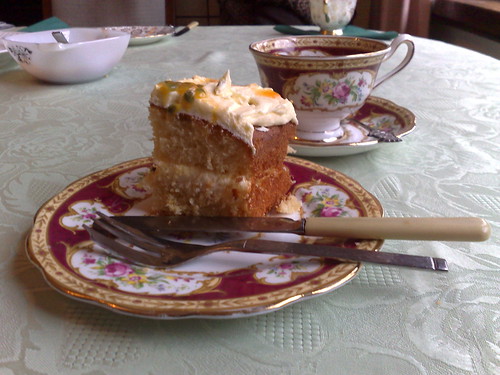
I think "Tea" is on of the most misunderstood and misinterpreted concepts out there. Afternoon tea, High tea, Tea, Dinner - all possibly meaning the same thing - or completely different ones.
So, let's go the panel and get a professionals' view.
AT HOME, HIGH AND FAMILY TEAS.
"At Home" Tea is served upon small tables, the servant before bringing it in seeing that one is placed conveniently near her mistress, who generally dispenses the tea. No plates are given for a tea of this kind, and the servant, or servants, after seeing that all is in readiness, leave the room, the gentlemen of the party doing all the waiting that is necessary.
The tea equipage is usually places upon a silver salver, the hot water is in a small silver or china kettle on a stand, and the cups are small. Thin bread and butter, sandwiches, cake, petits-fours and sometimes fresh fruit are all the eatables given. These are daintily arranged on plates, spread with lace doilies.
High Tea. - In some houses this is a permanent institution, quite taking the place of late dinner, and to many it is a most enjoyable meal, young people preferring it to dinner, it being a movable feast that can be partaken of at hours which will not interfere with tennis, boating, or other amusements. At the usual high tea there are probably to be found one or two small hot dishes, cold chicken, or game, tongue or ham, salads, cakes of various kinds, sometimes cold fruit tarts with cream or custard, and fresh fruit. Any supper dish, however, can be introduced, and much more elaborate meals be served, while sometimes the tea and coffee are relegated to the sideboard. In summer it is not unusual to have everything cold.
Family Teas. - At these meals cake, jam, sardines, potted meats, buttered toast, tea cakes and fruit are often provided, in addition to the tea, coffee, bread and butter. Watercress and radishes are nice in summer.
The hours for family teas may vary in many households, but are generally governed by the time of the dinner that has preceded them, and the kind of supper partaken of afterwards. Where this is of a very light character, such as a glass of wine and a slice of cake, or a more homely glass of beer and bread and cheese, a 6 to 7 o'clock tea would not be too later, and a few savouries or eggs would be needed in addition to the bread and butter and cake so generally found; but where a substantial supper is to follow the tea the latter would be of a very light description, and should be served as early as 4.30 to 6 o'clock.
Monday, September 14, 2009
What a toad-aly hole-some meal.
Well, when my (vegetarian) sister said we wouldn't be able to go to her house for dinner, I turned to my other (non-vegetarian) sister and said "Come to mine."
It was an excuse to make something with gratuitous meat in it. Just for fun. Oh, and lard too.
Not that there's anything wrong with being vegetarian (or vegan or pescatarian or pescapollotarian or whatever) but sometimes meat is fun. Turducken anyone?
So I went with Toad-In-The-Hole - which is not as gratuitous as it could be, but it's still meat in a yorkshire pudding, or as Special-Toad-In-The-Hole has it:- sausages wrapped in ham in a Yorkshire pudding covered in lard.
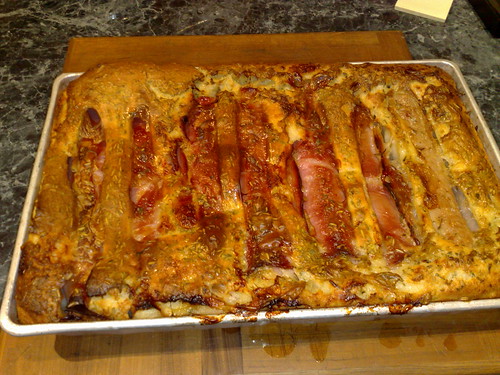
Mmmm, mmmm
TOAD-IN-THE-HOLE
INGREDIENTS. - 1 lb. of beefsteak (cut up small)
4 oz. of flour
1/2 a pint of milk
egg
salt
dripping
METHOD. - Mix the flour, milk, egg, and a little salt in a smooth batter.
Put in a Yorkshire pudding-tin sufficient dripping to form a thin layer when melted, pour in about a quarter of the batter, and bake until set.
Then add the meat, season it with salt and pepper, pour in the remainder fo the batter, bake quickly until it has risen and set, and then more slowly until sufficiently cooked.
Cut and serve in squares arranged neatly overlapping each other on a hot dish.
TIME. - To bake, about 1 hour. SUFFICIENT for 3 or 4 persons.
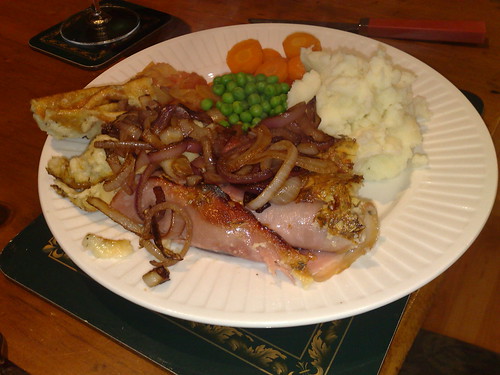
But what I've done here is use a different recipe, which oddly enough came with my electric beaters.
175g (6 oz) plain flour
pinch of salt
2 large eggs
200ml (7 floz) milk
200ml (7 floz) water
45ml (3 tbsp) fresh chopped mixed herbs, such as parsley, rosemary and thyme
8 good pork sausages of your choice
8 slices Parma ham
25g (1 oz) lard
15ml (1 tbsp) olive oil
2 red onions, sliced
method
Place the flour, salt, eggs and milk in a large bowl. Using the mixer beat for approx. 1 minutes, until well blended. Then with the beater still running gradually add the water and herbs, until blended. Leave batter to stand for 1 hour.
Preheat the oven to 22oC, 425oF, Gas Mark 7. Wrap each sausage in a slice of Parma ham. Place the sausages and lard in a large shallow roasting tin and bake for 10 minutes, until very hot.
Remove the roasting tin from the oven, pour in the batter and bake for 30-40 minutes, until well risen and golden.
Meanwhile heat the oil in a large frying pan and cook the onions for about 10-15 minutes, stirring occasionally, until caramelised. Remove the tin from the oven, scatter onions over and serve.
I thought it was pretty darn tasty. Also, my first true lard experience which was exciting. Although now I have 225 g of lard in the fridge just waiting for the next experiment.
It was an excuse to make something with gratuitous meat in it. Just for fun. Oh, and lard too.
Not that there's anything wrong with being vegetarian (or vegan or pescatarian or pescapollotarian or whatever) but sometimes meat is fun. Turducken anyone?
So I went with Toad-In-The-Hole - which is not as gratuitous as it could be, but it's still meat in a yorkshire pudding, or as Special-Toad-In-The-Hole has it:- sausages wrapped in ham in a Yorkshire pudding covered in lard.

Mmmm, mmmm
TOAD-IN-THE-HOLE
INGREDIENTS. - 1 lb. of beefsteak (cut up small)
4 oz. of flour
1/2 a pint of milk
egg
salt
dripping
METHOD. - Mix the flour, milk, egg, and a little salt in a smooth batter.
Put in a Yorkshire pudding-tin sufficient dripping to form a thin layer when melted, pour in about a quarter of the batter, and bake until set.
Then add the meat, season it with salt and pepper, pour in the remainder fo the batter, bake quickly until it has risen and set, and then more slowly until sufficiently cooked.
Cut and serve in squares arranged neatly overlapping each other on a hot dish.
TIME. - To bake, about 1 hour. SUFFICIENT for 3 or 4 persons.

But what I've done here is use a different recipe, which oddly enough came with my electric beaters.
special toad in the hole (you can tell it's a modern recipe due to the lack of capitalisation.)
ingredients175g (6 oz) plain flour
pinch of salt
2 large eggs
200ml (7 floz) milk
200ml (7 floz) water
45ml (3 tbsp) fresh chopped mixed herbs, such as parsley, rosemary and thyme
8 good pork sausages of your choice
8 slices Parma ham
25g (1 oz) lard
15ml (1 tbsp) olive oil
2 red onions, sliced
method
Place the flour, salt, eggs and milk in a large bowl. Using the mixer beat for approx. 1 minutes, until well blended. Then with the beater still running gradually add the water and herbs, until blended. Leave batter to stand for 1 hour.
Preheat the oven to 22oC, 425oF, Gas Mark 7. Wrap each sausage in a slice of Parma ham. Place the sausages and lard in a large shallow roasting tin and bake for 10 minutes, until very hot.
Remove the roasting tin from the oven, pour in the batter and bake for 30-40 minutes, until well risen and golden.
Meanwhile heat the oil in a large frying pan and cook the onions for about 10-15 minutes, stirring occasionally, until caramelised. Remove the tin from the oven, scatter onions over and serve.
Prep. time 15 mins; Cook time 40 mins
Serves 4 people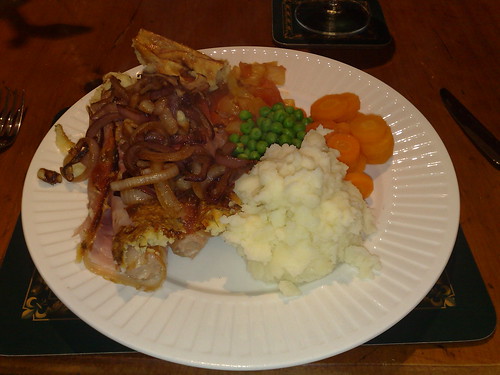
I thought it was pretty darn tasty. Also, my first true lard experience which was exciting. Although now I have 225 g of lard in the fridge just waiting for the next experiment.
Tuesday, September 1, 2009
Don't put all your eggs in one basket
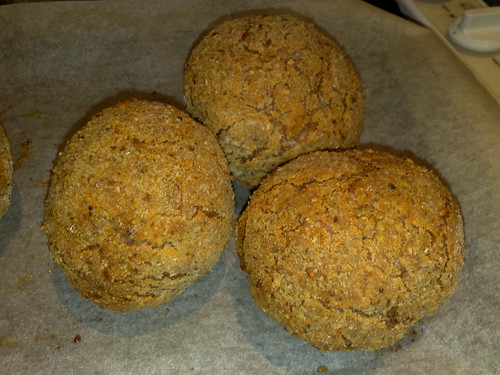
No, they're not dinosaur eggs, they're SCOTCH EGGS. A delicious and disturbingly awesome dish.
Pretty much, Scotch eggs are just protein. Eggs, wrapped in meat and fried (or baked).
Contrary to popular belief (and despite being the butt of a number of English comedians' jokes about the Scottish diet), Scotch Eggs were actually invented by the famous London department store, Fortnum & Mason in 1851 and are still available from them.
Anyway, hat's off to them, because they are scrummy. If you like eggs. And sausage meat. You could probably even use lean meat. Or maybe vegetarian sausages.
SCOTCH EGGS
INGREDIENTS. - 3 hard-boiled eggs
1/2 lb. of sausage meat
1 egg
breadcrumbs
frying-fat
6 croûtes of friend bread
METHOD. - Let the eggs become quite cold, remove the shells, and cover each one completely with sausage-meat.
Coat them carefully with beaten egg and breadcrumbs, and fry in hot fat until nicely browned.
Cut each egg in half, dish them cut side upwards on the croûtes of fried bread besprinkled with chopped parsley, and serve either hot or cold.
TIME. - About 3/4 of an hour. SUFFICIENT for 6 persons.
Or you can bake them in the oven, which is probably the healthier option. Very, very yummy, especially cold. Like a takeaway snack. Of pure protein. But if you look at my last post, I served it with the left over spinach pudding so I got some vegetables as well. Would be great at a picnic.
Subscribe to:
Comments (Atom)
